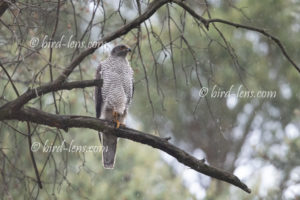 The rain is long awaited in southern Brandenburg, roughly 40 kilometers south of Berlin. The weeks before it had rained only sporadically. In the evening it was said that more than 10 liters / square meter had dropped. After strong thunderstorms with heavy heavy rain, the weather situation only calmed down slightly at night. There were other violent thunderstorms and storms during the night. Many nature lovers stay at home in these circumstances. But such a downpour can also be a good occasion to see how raptors in the forest deal with the rain and the water. For this reasen I had chosen my neigborhood Hawks (Accipiter gentilis) in the pine forest in my vicinity.
The rain is long awaited in southern Brandenburg, roughly 40 kilometers south of Berlin. The weeks before it had rained only sporadically. In the evening it was said that more than 10 liters / square meter had dropped. After strong thunderstorms with heavy heavy rain, the weather situation only calmed down slightly at night. There were other violent thunderstorms and storms during the night. Many nature lovers stay at home in these circumstances. But such a downpour can also be a good occasion to see how raptors in the forest deal with the rain and the water. For this reasen I had chosen my neigborhood Hawks (Accipiter gentilis) in the pine forest in my vicinity.
When I walk around a Northern Goshawk’s nest a little, a raptor suddenly flies in the rainy, foggy forest. It is the Northern Goshawk mother who has been sitting somewhere nearby, as she has done it every day for the past few weeks, keeping a watchful eye on the surroundings. I use my binoculars to search for the higher branches in the area and can quickly see the female Northern Goshawk openly perched on a pine branch some 250 meters from the nest. It is pouring with rain now. The female Northern Goshawk stands with a drawn leg in the feathers on a thick pine branch and looks down at me from time to time. Then she turns her head again to secure the airspace. The female Northern Goshawk keeps a watchful eye on the surroundings and eventually flies away with grace between the narrow pine trees.
A few days ago, a strong thunderstorm fell over the Nuthe-Nieplitz lowlands in southern Brandenburg. Actually a change to look for the young Northern Goshawks in their nest and see how the young Northern Goshawks handle the water, which is certainly still unusual for them. When I arrive, a bird flies out of a pine tree. It is the most developed of the young Northern Goshawks that had made its first excursion the days before. It does not get very far and lands a little further. It sits a little way up in a pine tree next to the nest. Its brown-gray plumage with the distinctive black lines on the chest and belly is colored inconspicuously enough so that it does not appear too strongly in front of the pine bark. But now it is sitting freely on a branch and is easy to see. The nest is quickly found again. There is not much to see from the other siblings. They are still sitting on the nest and have probably pressed themselves onto the bottom of the nest. No wonder: the weather is rather hot and humid, but damp and rather uncomfortable.
One of the nestling Northern Goshawk is now slowly becoming active. Another sibling – also in brown-gray plumage with striking white dunts on the chest – sits on the edge of the nest and looks down to the grouond. It can be seen that both young Goshawks were anything but made up of the weather. The high humidity also seems to activate the flies and especially the mosquitoes. Again and again the heads of the birds are thrown aside to defend. As the rain increases in strength, I also get nice shots of the young birds, which wait for the downpour to get wet and angry.
Even though Berlin is more known as a Northern Goshawk stronghold in Germany, Northern Goshawks can also be found in the vast landscape of southern Brandenburg. However, while several observations of breeding pairs from the Berlin boroughs are reported in spring, the reports from the Northern Goshawk in Brandenburg are much sparser. There is almost no evidence of breeding in the official records on websites like www.ornitho.de. This could be due to the fact that ornithologists want the Northern Goshawk to be kept away from pigeon guards and perhaps also hunters and therefore do not provide any corresponding location information. It was more by chance that I came across a breeding couple near my home town. Not far from the place where 3 young Northern Goshawks were spotted an entire morning in mid-July last year, a Northern Goshawk called its courtship call from the inside of a light pine grove in early March this year. Now the nest is occupied with 3 young Northern Goshawks in the middle of the forest.
In order to meet the growing demand for top images of the rarer species of Palaearctic Bird-lens.com has specifically made trips to remote places. Additionally every chance is used, if a rare bird is around the homeground. This to do everything to ensure excellent photos of the Birds of the Western Palearctic . The yield of pictures also of rare Western Palaearctic birds is very good. There are other nice images of birds, that you will find behind the tab “Picture Shop“. Just give a notice if you need a picture of a bird which is not online.